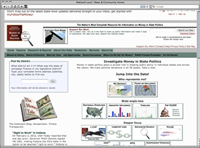Bender began his career in Alaska and Washington doing the journo’s bread and butter–crimes, cops, politics–as well as a five-year stint at the Tacoma News Tribune copy desk. Eventually he and his wife decided to return to the open spaces of Montana, where Bender graduated from the University of Montana’s journalism school in 1981.
Once there, Bender became part of a new project funded by the MacArthur Foundation that gave five regional teams in the United States resources to gather and digitize state campaign finance data.
“No one had ever done this kind of stuff before: Profiles of who donated the most to legislatures as a body, as well as individuals,” says Bender. “We had some pretty big stories, like the Nevada gaming industry. Everyone knew the gaming industry owned Nevada, but no one knew how much.”
In 1999, the project became a stand-alone organization based in Helena, Montana called the National Institute on Money in State Politics. A non-partisan 501c3 organization, it aims to reveal the influence of campaign donations on elections and public policy in all fifty states.
Bender is the executive director of the organization and its site, www.followthemoney.org, which is a portal into 25 million records dating back five election cycles that any journalist, academic, student, or citizen can access for free. According to Bender, traffic to the site has steadily increased over the last two years. But 2012 has so far broken previous records for unique visitors: over 170,000 people have used the site since January to view their campaign finance data.
Followthemoney.org attempts to create as many entry points as possible into it’s massive collection of data–a feature which aids usability while also giving the numbers context and meaning. There are over a dozen tools available for narrowing in on specific data. For example, a visitor to the site can go to the My District tool, type in their address, and be given a profile of their district that includes who has given money to each candidate in an election. The Point of Influence tool overlays contribution data with legislative district boundaries, and a visitor can then filter by candidate, ballot measure, party committee, or industry. If a user wanted to search by health insurance companies, for instance, he or she could see how much money the industry gave by state, and which legislators in an individual state received the funds.
The most powerful tool, in Bender’s opinion, is the Legislative Committee Analysis Tool, or L-CAT. It allows a user to group data for elected lawmakers by committees that they sit on, and then filter the donations by industry. “It illustrates the intersection of campaign money with the laws that affect everyday life,” explains the language on the site.
Tools such as these can hopefully lead to a new level of accountability over the long run, though Bender is careful to point out that there are fifty distinct state governments with different influences operating in each. Tracking them, making sense of them, and engendering civic awareness is not easy.
“The health of our electoral system is not good,” says Bender. “We just did an analysis that shows that in 25 percent of legislative districts in the country, there is only one candidate running. In another 45 percent you have one candidate who raises twice as much as the other person. Ostensibly, that’s not competitive either.”
The National Institute on Money in State Politics is 96 percent funded through foundations such as the The Pew Charitable Trusts, Rockefeller Family Fund, and Open Society Foundations, among others. The remaining 4 percent of revenue is accrued through customized data that academics, newspapers, or various institutions request from the organization and pay for. Bender says the organization will eventually offer licensing agreements to newspapers, which will pay for a reporter to be able to run custom data queries on the organization’s server.
The National Institute on Money in State Politics currently employs twenty-two staff members, including eight people solely dedicated to acquiring raw data from states. Another six researchers code and analyze the data, and there are two programmers on staff (one self-taught and the other with a PhD in artificial intelligence). The organization doesn’t take advertising on its site and doesn’t work with political parties. “We think of ourselves as fairly agnostic,” says Bender. “We do the data and make it available.”
As for the future direction of the organization, Bender says that they have accrued enough information over five election cycles to be able to conduct deep analysis on the health of the electoral system and prescribe better policies.
“We have enough evidence beyond telling a good story,” he says. “We can start thinking about what can we do as a democracy to make our country better.”
 HELENA, MONTANA — Edwin Bender believes that building a database is like writing a really good story. “What fascinated me about being a journalist was getting down and taking evidence and saying ‘this is what I see,'” says Bender. “When I first started building databases it was like reporting a story. Standardizing names and sorting them, finding out who worked for a bank when they said they were retired. There was a lot of shoe leather reporting.”
HELENA, MONTANA — Edwin Bender believes that building a database is like writing a really good story. “What fascinated me about being a journalist was getting down and taking evidence and saying ‘this is what I see,'” says Bender. “When I first started building databases it was like reporting a story. Standardizing names and sorting them, finding out who worked for a bank when they said they were retired. There was a lot of shoe leather reporting.” 
